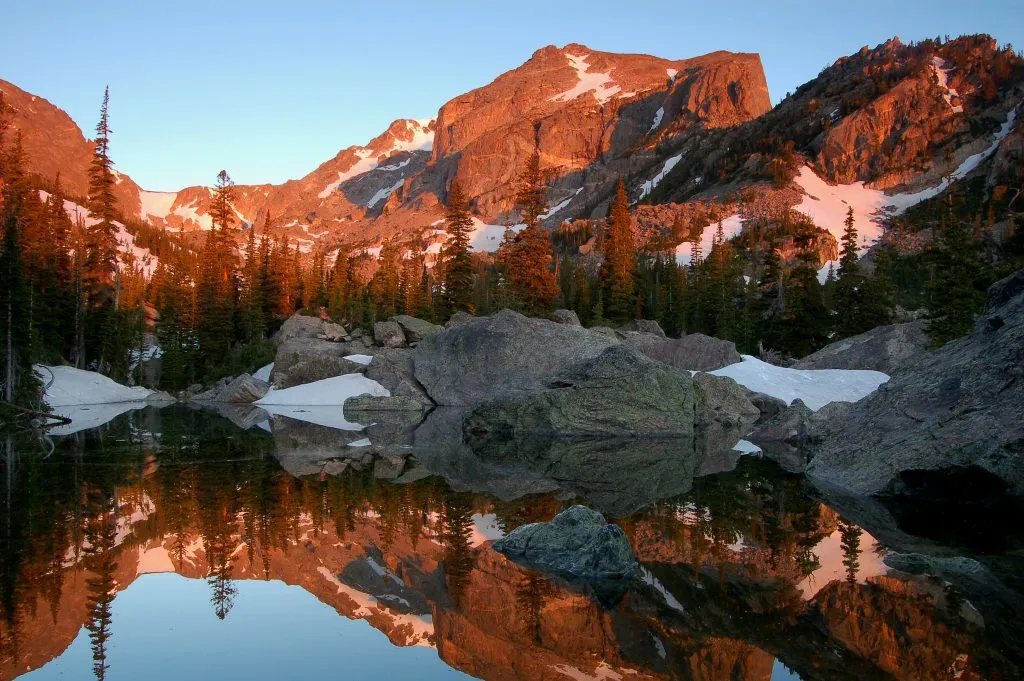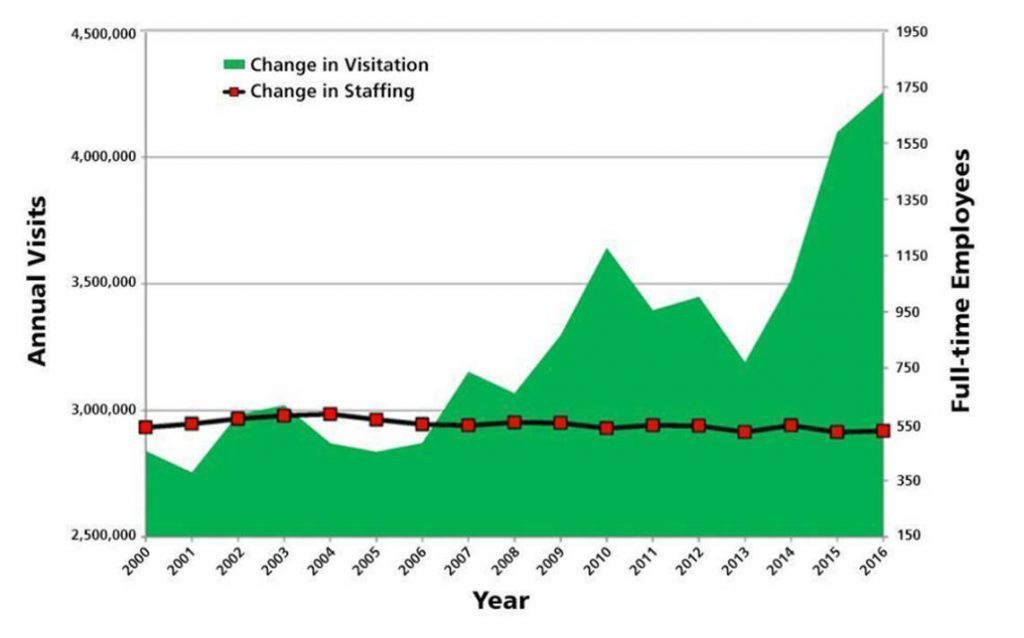U.S. National Parks Boom Is Great But Overtourism Solutions Needed Urgently, Say Senators

Skift Take
The pandemic’s overtourism effect on the U.S. outdoors came into greater focus last summer, when a record number of crowds flocked to the U.S. national parks and surrounding gateway communities, many of whom as first-time visitors who’d never explored their backyard.
But it’s not the increase in visitation and outdoor economy boom that’s a bad thing per se — rather, the urgency lies in identifying and implementing crowd management strategies for the next five to 10 years in the most visited national parks, and these won't be "one size fits all."
That was the crux of what leaders in government, including National Park Service superintendents and tourism representatives, agreed to on Wednesday at the Senate Energy and Natural Resources’ Subcommittee on National Parks’ hearing to review the impacts of overcrowding on national parks and visitor experiences, and to listen to proposals for long-term solutions.
“It’s great to see so many Americans are taking advantage of these parks,” said Senator Angus King, an independent from Maine. “However at the same time we must recognize that overcrowding in the parks can degrade the natural resources and wildlife that these units are designed to protect. We can accidentally love our parks to death.”
According to Kristen Brengel, senior vice president of government affairs at National Parks Conservation Association, the parks had 327 million visits in 2019 alone, with record breaking results expected this year. Yellowstone National Park has already shown a 40 percent jump in April, Brengel said, while Zion National Park can have a four-hour wait to access the trail heads.
How can the National Park Service and the business community embrace the economic boom while preventing ruining the visitor experience and straining the resources of gateway communities? Multiple solutions and ideas were put forth, some of which are currently being tested, ranging from timed ticketing systems to shuttle use increase to reduce traffic volume within the park, and the need for more digital tools to educate and identify hotspots.

Other challenges identified amid the overcrowding conversation: staffing at national parks which hasn’t kept up with visitor growth — it's tanked by 16 percent since 2011 — and equitable access for diverse families, as well as for communities that live in the shadow of these protected areas.
The road is long and complex, but the discussions taking place among the public and private sectors are an encouraging sign of confronting one of the biggest issues the outdoor travel industry is facing.
Redirecting Crowds and Traffic
Out of the country’s 423 national parks, half of the visits are taking place at 23 parks, with significant congestion conditions concentrated between 12 to 15 of them, said Michael Reynolds, regional director at the National Park Service overseeing 85 parks spanning Texas, Oklahoma, New Mexico, Colorado, Utah, Wyoming, Arizona, and portions of Montana, which host 57 million visitors annually.
Reynolds said that a range of strategies were now being used at a handful of parks to tackle overtourism, including working with local and regional tourism entities to promote sustainable travel, addressing vehicular congestion through use of shuttles, as well as creating multi-use paths for biking and walking.
“Timed entry systems are now in place at several parks — Acadia National Park implemented a vehicle reservation system … Glacier, Rocky and Yosemite national parks have a timed entry ticketing system as pilot projects with each addressing a specific park level issue,“ said Reynolds.
Rocky Mountain National Park is also currently piloting a timed entry system for park wide access, which spreads visitation and decreases congestion and queuing in parking lots.
Kevin Schneider, superintendent at Acadia National Park, said that the new reservation system at the parks's Cadillac Mountain was receiving high praise from visitors.
“We’re hearing that sentiment online in reviews. There’s only 150 parking spaces on Cadillac Mountain and not everyone can be up there at the same time. It wasn’t unusual to have 500 cars prior to the reservation system.”
Dispersal Tools Must Include Tech and Campaigns
Senators were particularly interested in knowing how the National Park Service could turn to technology to plan congestion relief long term, but also to educate visitors on lesser known parks and sights — and in multiple languages.
Reynolds agreed that embracing technology was a very important part of the puzzle, pointing to the NPS mobile app, and the possibility of it having the seeds for those solutions.
“This is one of our challenges, we’re park people not necessarily programmers but we have a lot of allies and stakeholders to help us with this. We are pushing ourselves to find ways to work with those that are already doing these things.”
One method of dispersal is by using digital newsletters, and campaigns.
“We ask superintendents in lesser visited parks to be very aggressive with education and outreach, work with regional tourism boards to help them highlight their sights, and encouraging special events or educational programs to attract new visitors,” said Reynolds.
NPS could do a much better job of informing Americans, Reynolds added.
“Once they’re in a region of an area, we have ways to use our new mobile app recreation.gov to know about these places. We are working in a field of emerging mobile tech and this can range from tracking vehicles using bluetooth to track vehicles. We have bandwidth and connections in the west. But yes we have ways to get our partners in the highway administration to help us manage and get the word out.”
Kevin Gartland, executive director at Whitefish Chamber of Commerce, in the gateway town to Glacier National Park, noted that the recent ticketing system at the park caused problems because of the late implementation decision, less than 60 days before peak summer season, and the lack of advance notice to visitors and stakeholders.
“We need to decide that’s happening next summer within the next couple of months," said Gartland. "People reserve one to two years in advance. So folks are making those reservations a long time in advance… they had no chance to know this was here.”
Gartland said that a comprehensive campaign would also be needed to get the world out because despite the park staff efforts, there is still uncertainty and frustration about how the new system works.
Educating the Ugly American Tourist — at Home
National Park Service and private sector leaders agreed that visitor education is a key part of the solution, which can be addressed via marketing campaigns as well as through multilingual signage and additional social studies.
The National Parks Conservation Association’s Brengel said that parks were facing serious issues with visitors increasingly heading off trails and disturbing wildlife, engaging in vandalism such as defacing indigenous rock imagery, as well as dealing with upticks in graffiti, litter and improperly disposed human waste.
“This undesirable and harmful behavior suggests unprepared visitors are recreating in parks and the need for more interaction with park rangers to educate visitors.”
Reynolds said that the National Park Services’ “Plan like a park ranger” campaign supported visitors “by advising them to have back up plans, know in advance where reservations are needed and encouraging people to explore the lesser known parks.”
Getting to people before they arrive is also key, and running studies for more details on visitor patterns in terms of where they’re coming from and going.
“But really getting the word out, before you leave the house — what is the situation on the ground, that’s something we are exploring," said Reynolds.
Equity and Inclusion Must Be Re-examined
The National Parks Conservation Association’s Brengel also raised the topic of equity and diversity in managing national park visitation, an issue that's been at the forefront of reimagining the future of access to the U.S. outdoors and its national parks.
“We believe the park service needs to critically examine making parks more welcoming and relevant for Black, Indigenous, and people of color,” said Brengel. “In this regard we think safety needs to be reviewed.”
Brengel added that language and communication must go beyond just English, and that user fee increases were not effective in addressing increased visitation but rather could impede access for low income populations.
As an example, Brengel said that last year’s reservation system implementation at Yosemite National Park led to findings that Latino day visitors struggled with the English-only information about getting into the parks and weren’t aware of the reservation system.
Social science data is also lacking and needed on visits from low income families and what is deterring them in visiting national parks and getting weekly or day passes.
“We fully embrace this need for equity and inclusion, with our diverse visitors now becoming the face of America,” said NPS’s Reynolds, while stating that implementing a multilingual approach would be a challenge.
Tighter Collaboration: Local Communities Must Be Accommodated
Senator Mike Lee (R-UT) pointed to the success of the public-private collaboration in the East Zion National Park initiative, as a way of dispersing visitors towards underused areas. Reynolds agreed that the multi-stakeholder engagement process led to the success of that vision.
“We should be looking at Zion conversations as a model that we should strive for in other parks. Because having everyone at the table will avoid the problems," said Reynolds.
Whitefish Chamber of Commerce’s Gartland said that one of the major issues with managing crowds and national parks, particularly in the case of Glacier National Park’s new ticketing system, was ensuring that the gateway communities also had access to their own backyard.
“Locals are feeling like they've been left out; these folks who live and work here, they have park passes and they're competing with three million other people to get a limited number of daily tickets to get into the park," said Gartland, adding that one of the chamber of commerce's main roles is to maintain quality of life.
"We have to find a way to accommodate them, and I think there's a lot of issues regarding how we can prioritize who can have access to the park or not, but those are some of the tougher decisions that have to be dealt with."




